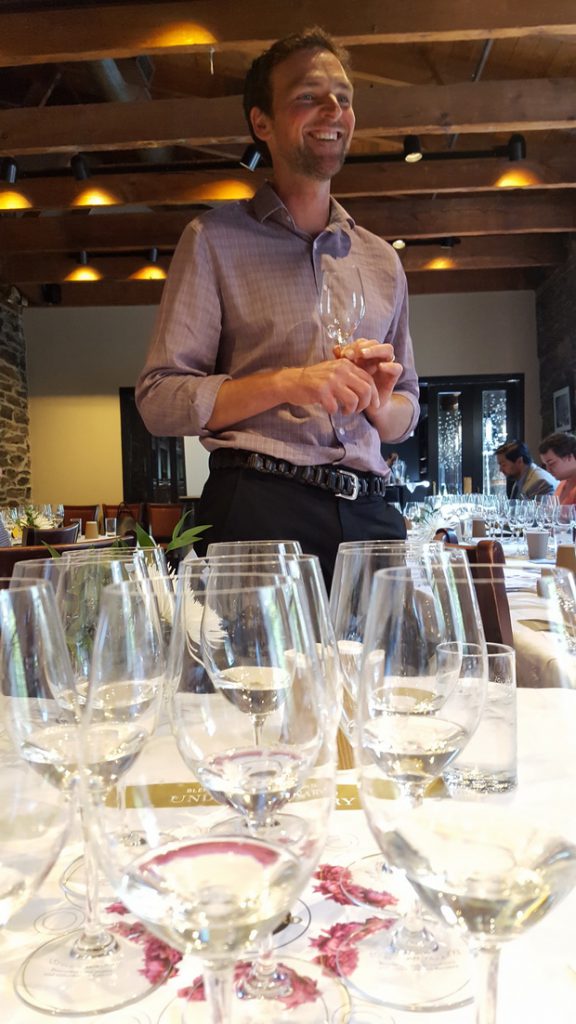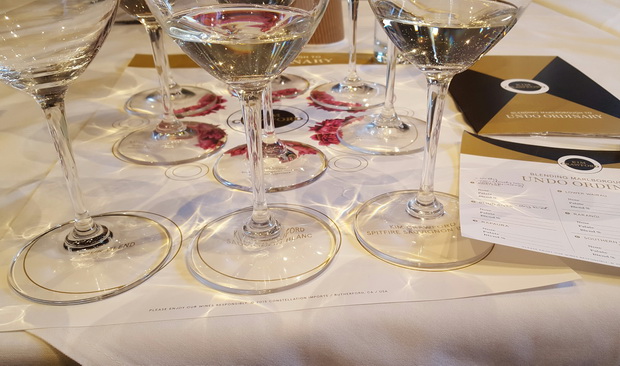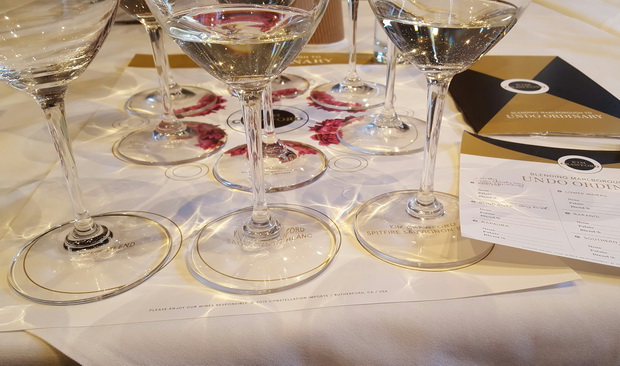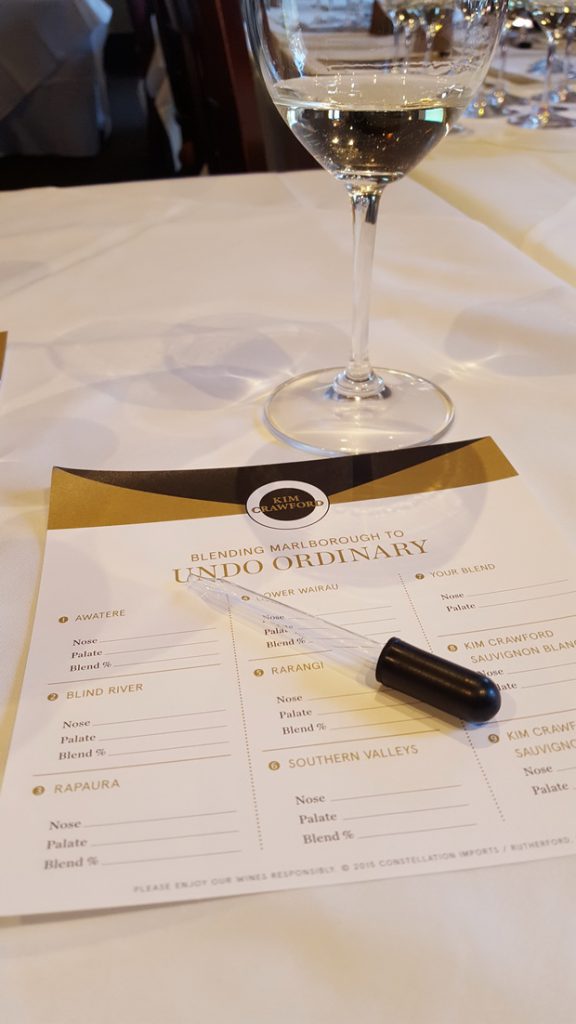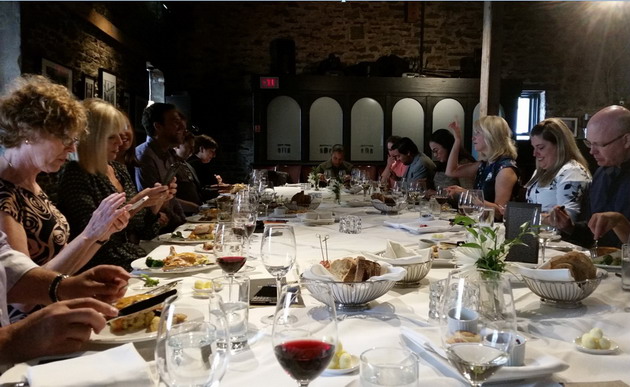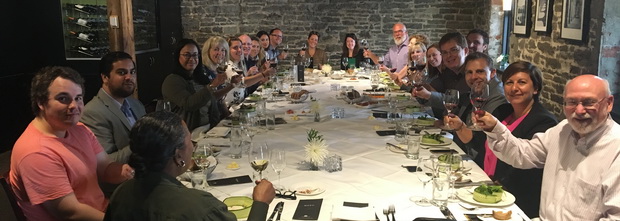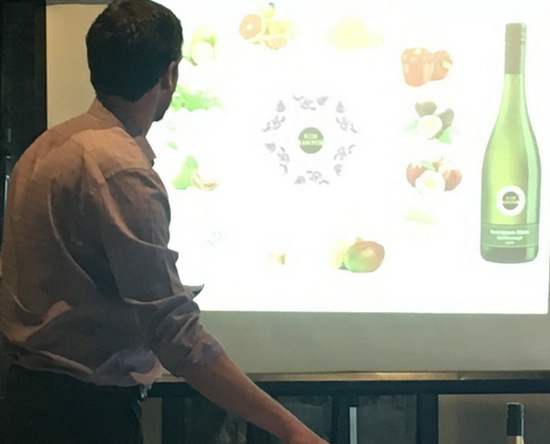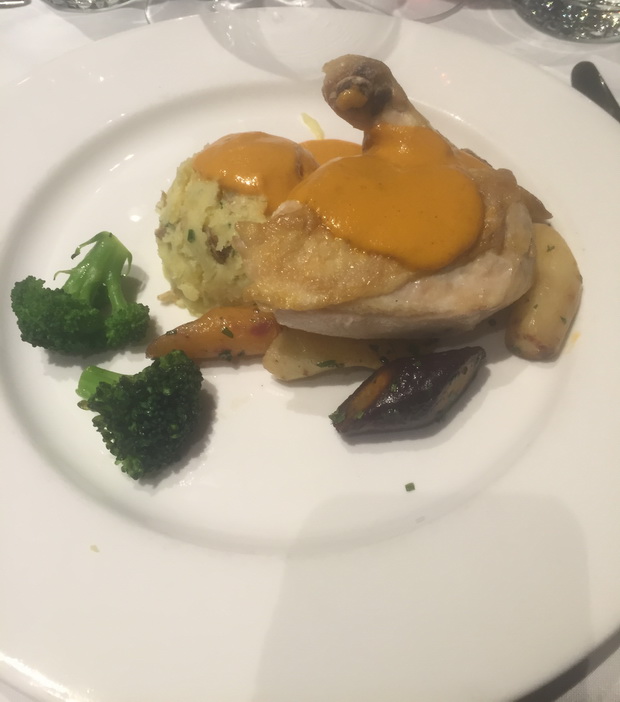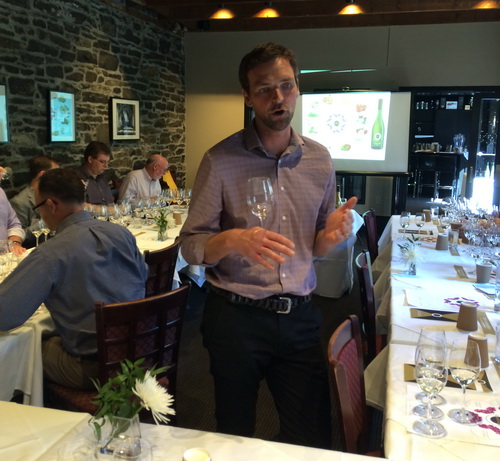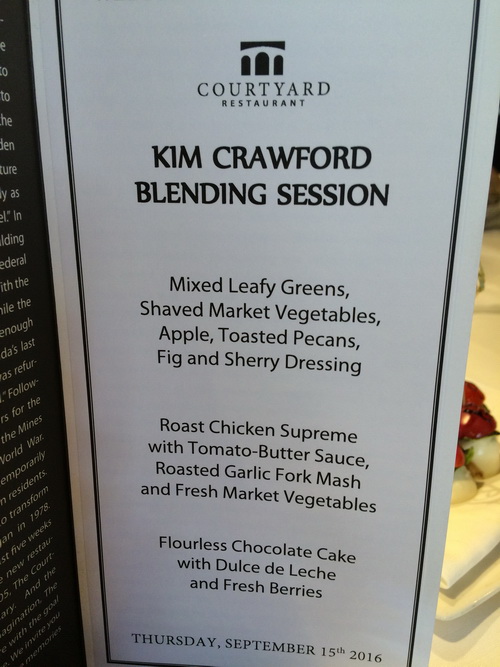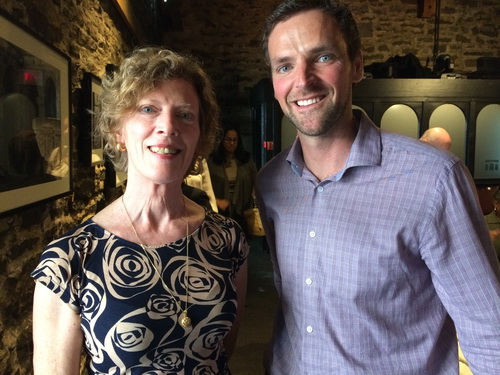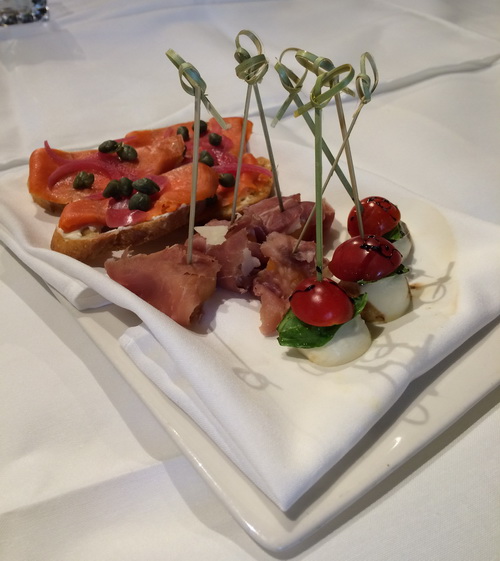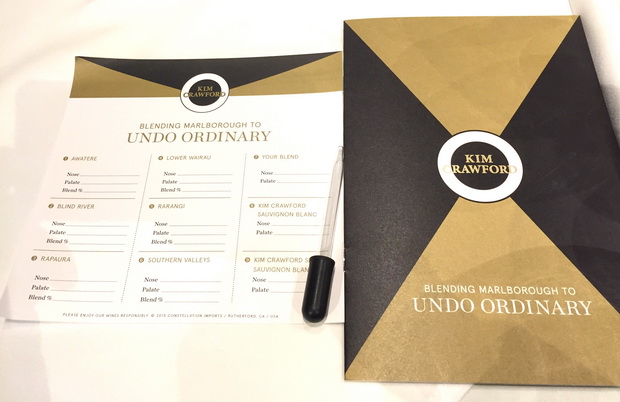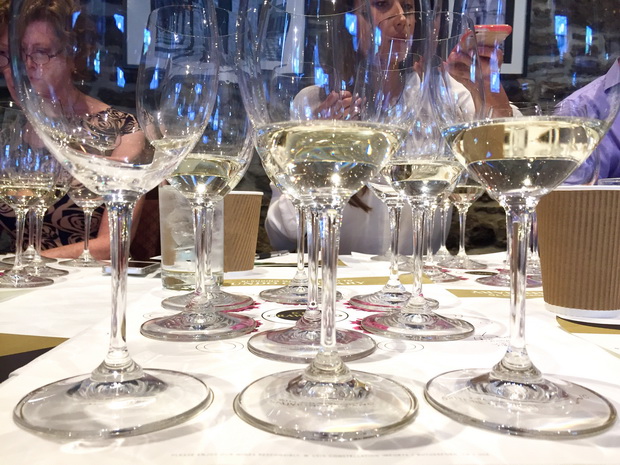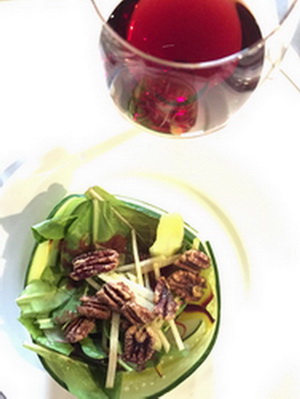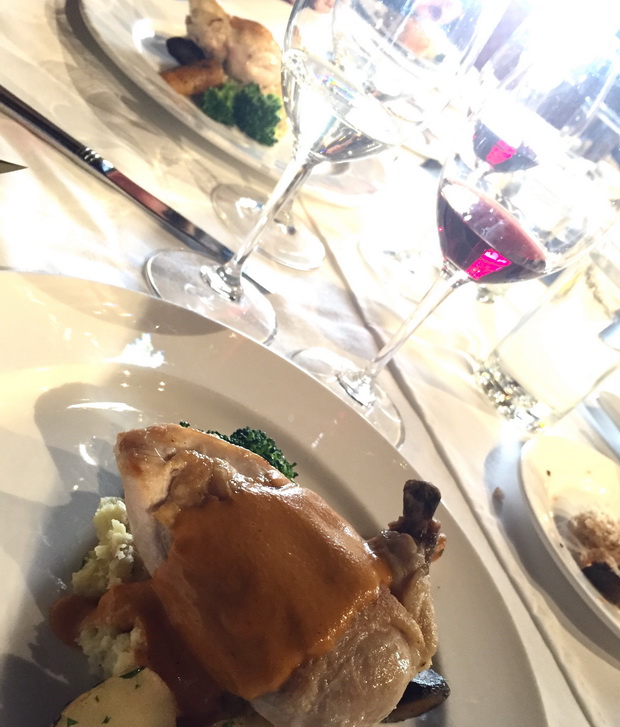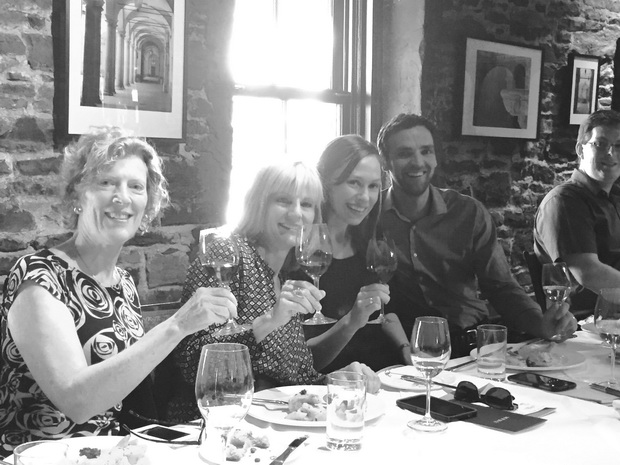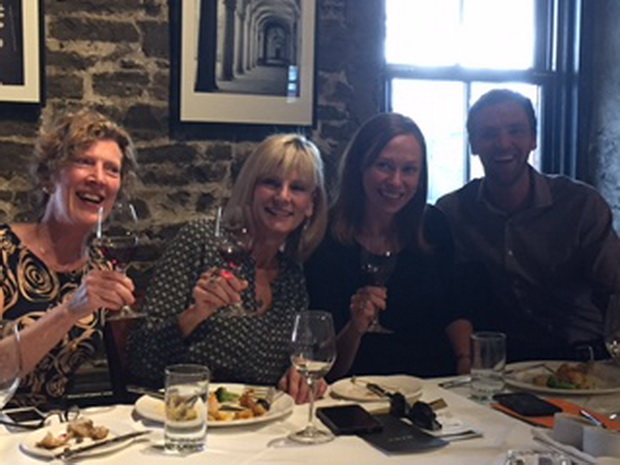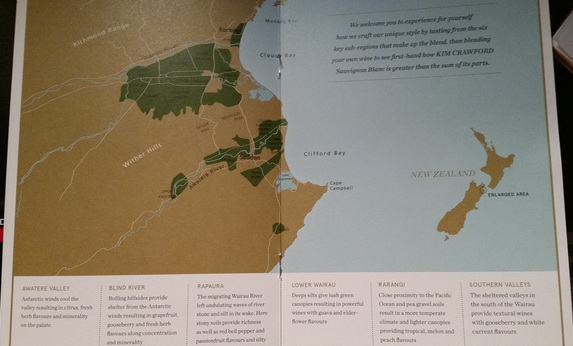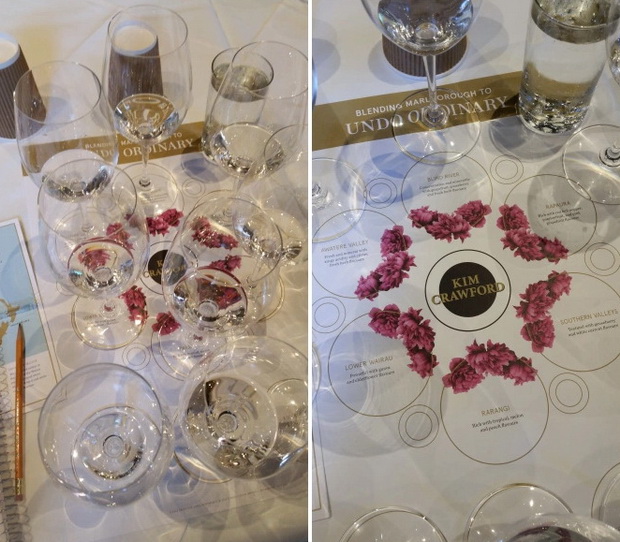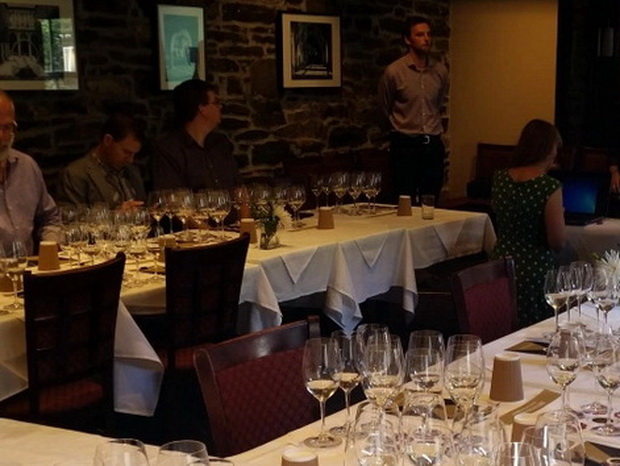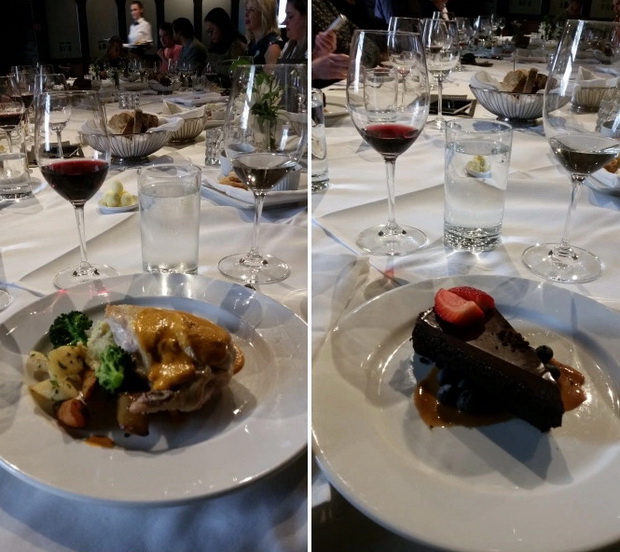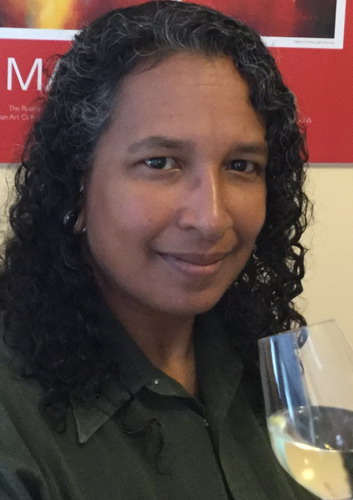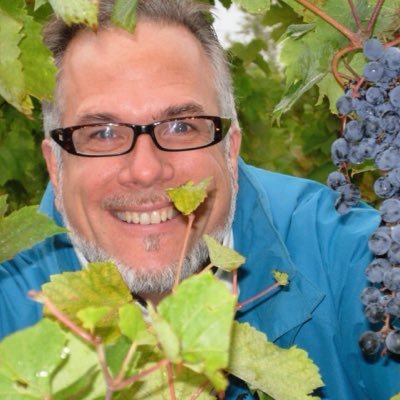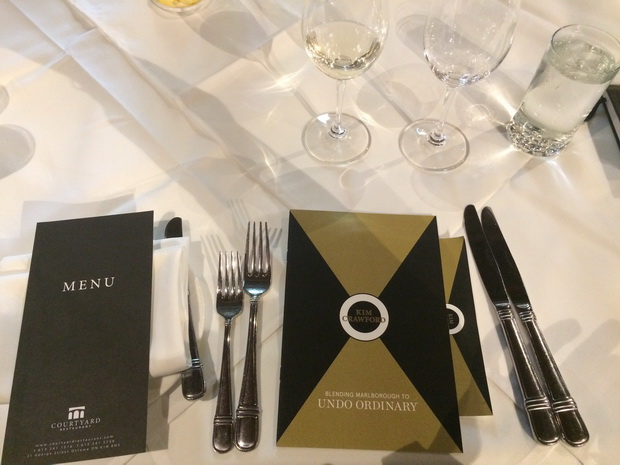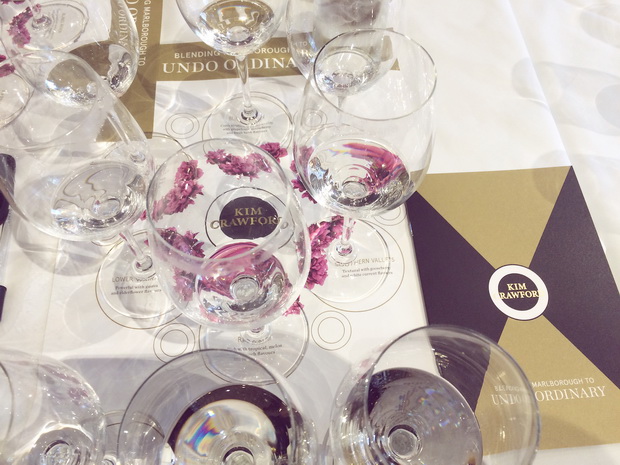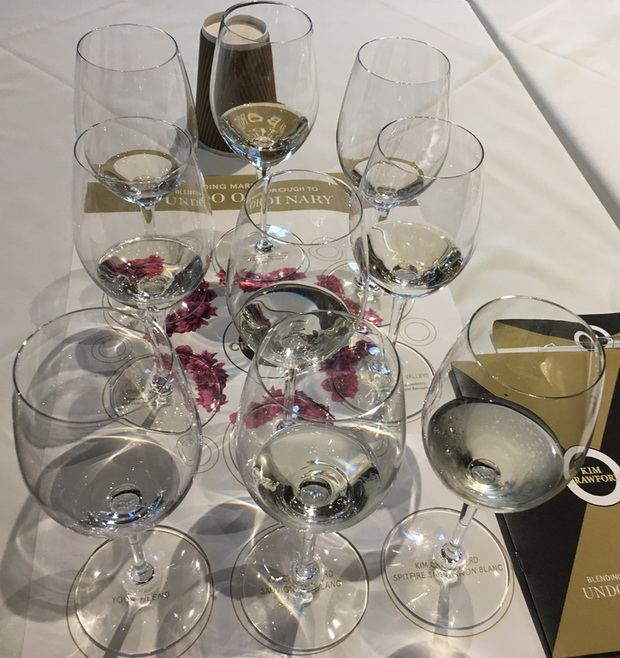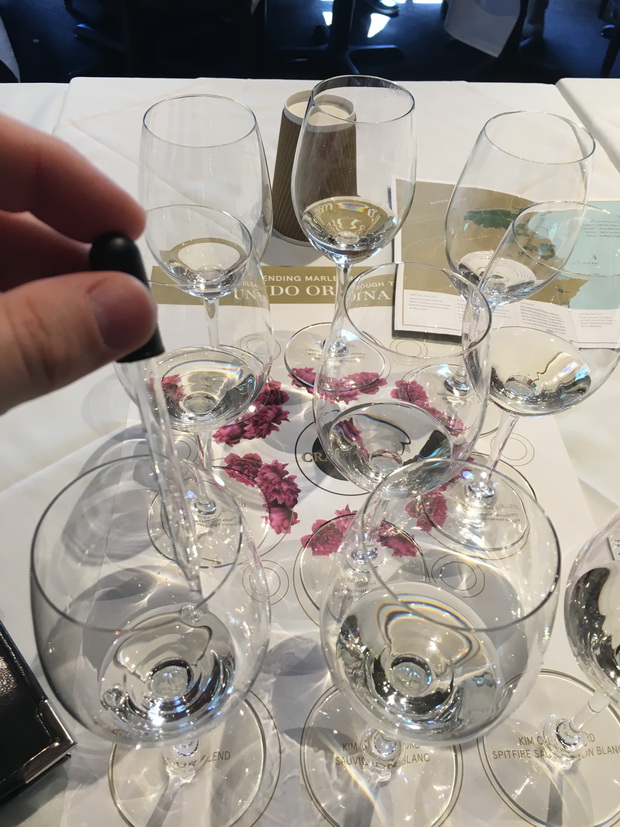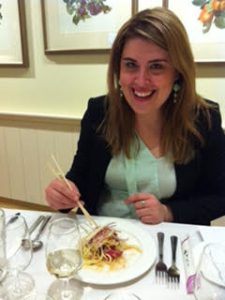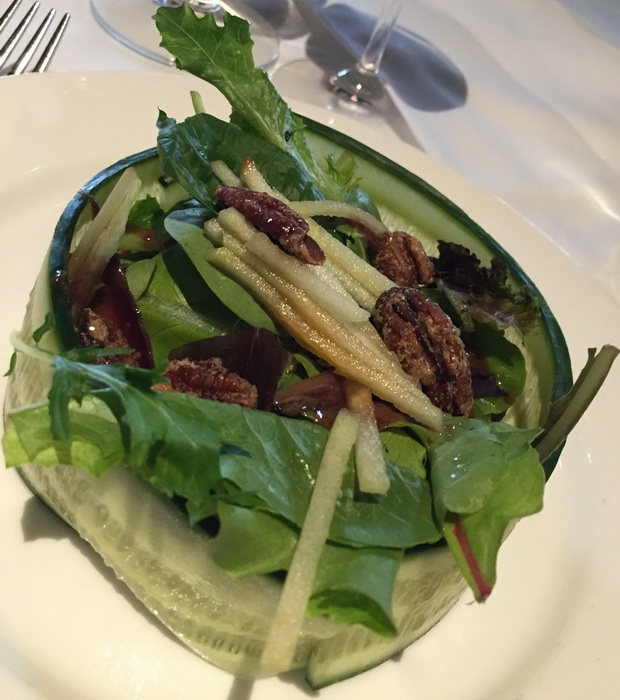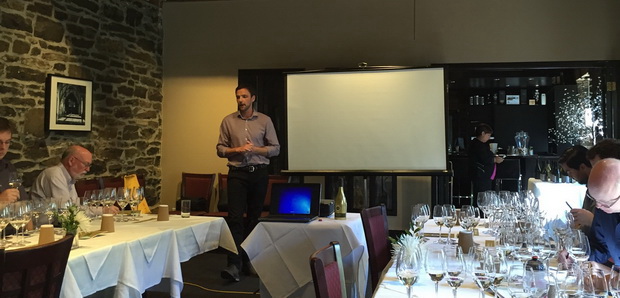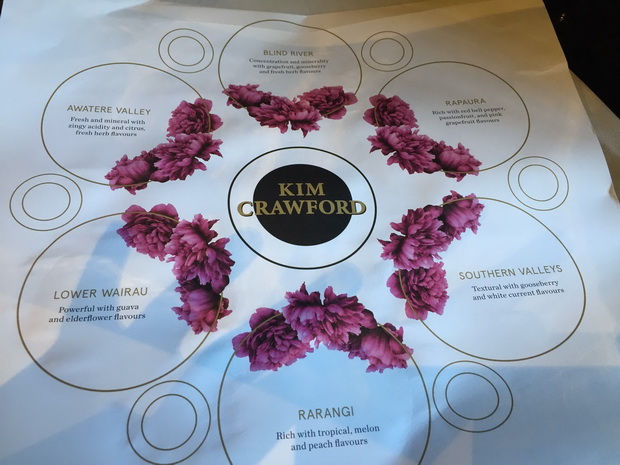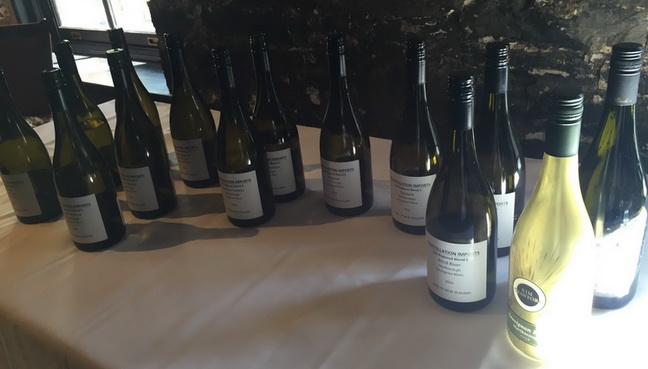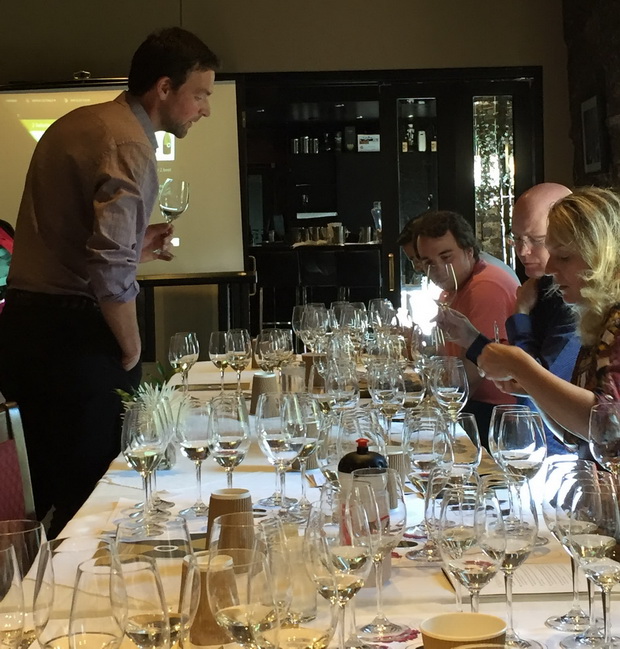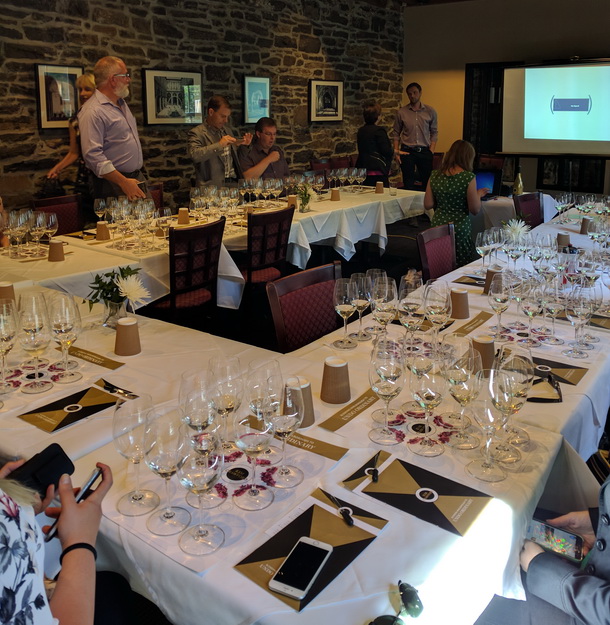In the video above, Kim Crawford Winemaker Anthony Walkenhorst explains how blending works at the winery as we try our own hand at it.
Canada’s top wine writers and sommeliers met in our nation’s capital recently for a fascinating tasting, and blending exercise, with Kim Crawford wines.
Jennifer MacDonald Havers
Wine Columnist, Ottawa Citizen
Upon entering a beautiful dining room at Courtyard restaurant, our group knew our tasting with Kim Crawford wines was going to be a unique experience.
A huge table set with multiple glasses, all but one at each setting containing a sample of Marlborough Sauvignon Blanc.
The classic Kim Crawford Sauvignon Blanc as well as the Spitfire Sauvignon Blanc, a small parcel (or Reserve-type) version were in two glasses. The rest were all labelled for different areas – different individual vineyards, we soon learned.
The final glass was empty and labelled “Your Blend” – interesting.
Our task for the day was to learn what regional components go into Kim Crawford Sauvignon Blanc and then we would try to create it ourselves. Of the 240 vineyards that Kim Crawford either owns or has access to, these were some of the wines made from individual vineyards, each vinified separately to capture the essence of that site, soil, and microclimate.
Winemaker wannabes at work …
These individual wines gave us a glimpse into the task of the winemaker for each vintage. Through extensive tasting and blending, they create the flavour profile of their flagship Sauvignon Blanc, sampling through all of the different potential flavours, and eventually narrowing it down to what will create the ideal blend.
Each individual wine brings a certain characteristic to the final blend. The region of Awatere displayed bright citrus, fresh herbs and tomato leaf notes. Blind River comes from a hilly site, and the resulting wine shows a lot of gooseberry and grapefruit notes.
Rapaura has some 30+ year old vines, with river stones in parts of the vineyard reflecting warmth onto the vines, adding rich notes of passion fruit. The Southern Valleys wine comes from more consistent soils, and had more texture, along with white peach notes.
Rarangi vineyard is close to the coast, ensuring cooler nights which help to preserve acidity in the wine. The Lower Wairu vineyards have fertile soils, and the wines have a lot of elderflower and guava notes.
It was fascinating to see and taste this range of wine, all being Sauvignon Blanc, and contrast their differences.
Now, with those samples in front of us, we tried to create a blend of our own wine, thinking of these individual characteristics and what works together. What would bring that crisp acidity? Which wine would provide that texture and body, but balanced with zesty citrus and tropical fruit flavours.
Not an easy task …
A few members of our team were thrilled with their creations, and even named them! Mine was nothing special (I won’t be recommending my ratio to Kim Crawford for production, that’s for sure).
However, what I discovered and what was so ingeniously demonstrated to us, was how site specific conditions can contribute to the character and flavours of the wine, and how the winemaker can craft a desired flavour profile using his ingredients or tools, all from the vineyard.
All of the ingredients were Sauvignon Blanc, but each brought something special to the overall blend.
I definitely will look at this wine with renewed respect for the complexity and attention to detail that has gone into the bottle.
What a treat! Not only did I enjoyed an afternoon tasting brilliantly crafted New Zealand Sauvignon Blancs from distinct regions in Marlborough, but I also got to experience a fine lesson in blending wines with an amazing group of wine writers.
Before I continue any further, blending is no joke. It is a delicate art and it is hard work. Blending is where winemakers really show off their talent and it requires a mound of skill.
A skill I know I am nowhere near grasping… just yet. So, let’s just say I have embraced an even higher respect for winemakers after this exercise.
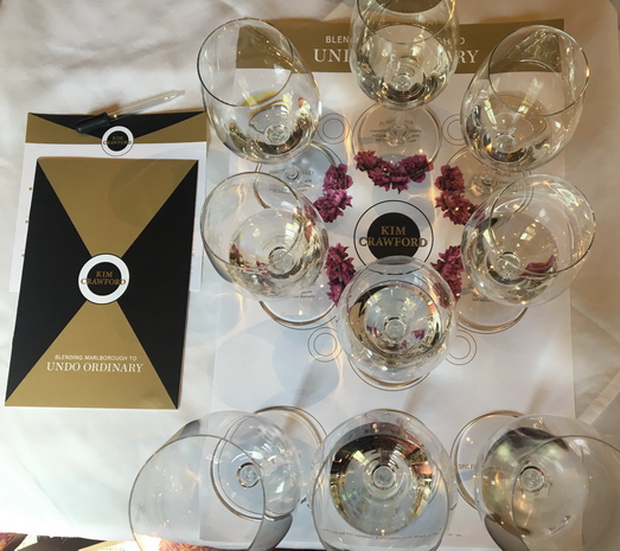
We tasted through six different Sauvignon Blanc from distinct sub-regions in Marlborough and guess what?
No! They don’t all taste the same!
The spectrum goes from nuanced fruity and floral notes to drastic mineral and textural notes, leaving the winemakers of Marlborough to balance this all out in hope of creating a standout blend of Marlborough Sauvignon Blanc.
So, my big question to Kim Crawford winemaker – Anthony Walkenhorst – was… “How do you accomplish your ‘stand-out’ blend? ”
… and here is how he does it:
1. You do it blind! From the very beginning, i.e. right after the grapes are harvested, he starts blind tasting the soon-to-be-wine, meaning he doesn’t know where the wine comes from while he’s tastnig. So, there are no preconceptions at all. That doesn’t mean that from their experience they couldn’t accurately guess where they were sourced from, though.
2. Anthony then sets a basic level of style for each growing sub-region of Sauvignon Blanc that he tastes. His categories are quite simple: from floral, fruity, grassy, mineral, vegetal… you get the picture.
3. Then, he tastes it again and again and again…. You can never taste it enough! After all, this is your prized blend.
4. Then, he starts to categorize the “big players” from the less distinct ones. These “big players” get their level of categorization from showing unique body, texture, aroma and/or flavour profile, and overall balance.
5. Anthony says, he will then move on to trial-and-error blending.
6. And finally, the job is done! I hope he then just has a beer, but who knows! I should have asked him that.
Patience, practice, and experience are what gets you to your goal. It’s the same values that get your winemaker to craft some well-balanced wines. Let’s remember that the next we sip on some nice wines.
Anthony answers our questions
Anthony telling us about the use of contract wineries.
David Skinner
Wine & Travel Columnist, Outdoor Magazine
Anthony Walkenhors has earned his reputation as a winemaker through his persistent pursuit of excellence and the desire to craft the distinctive flavour profile Kim Crawford wines are known for around the globe.
His skills at combining wines from diverse terroir were on display as he guided some of Ottawa’s best palates through a Sauvignon Blanc blending workshop at the Courtyard restaurant.
Creating a blended wine that meets a desired specification for aroma, taste, acidity, body and balance requires a solid understanding of how wines from different microclimates, soil and topography can work together harmoniously in the final product.
That’s made even more complicated by the extensive plantings that Kim Crawford wines has to choose from.
With 240 individual blocks under vine, there is more than enough diversity in the grapes that go into either the small parcels offerings or their ubiquitous Sauvignon Blanc blend.
For the latter, 120 different vineyards contribute wine to the final offering with six distinct regions represented. Wines are made from each of these vineyards and blending is done from the fermented grape rather than in barrel or tank.
Each region is chosen for its specific attributes that express themselves not as individual elements but more as a synergy that is clearly greater than the sum of its parts.
The Lower Wairau Valley produces rich wines of great power and those from this region form the backbone of the Kim Crawford Sauvignon Blanc.
In seeking a finished product that has a predominantly tropical fruit profile accented by citrus, two regions make their presence known for melon, peach and pineapple notes. The Rapaura and the Rarangi regions provide the tropical boost and just a hint of grapefruit while wines from the Southern Valleys contribute texture and some of the classic gooseberry elements.
Finally, wines from the Awatare Valley and Blind River give the finished product an herbal aspect and minerality respectively. The end result is a carefully crafted creation sure to satisfy fans of Marlborough’s best known wine.
The writers gathered for this event were also treated to a taste of the Spitfire Sauvignon Blanc. Made from less than 1% of the total production, this small parcel wine changes each year to meet the desired specifications of the winemaker.
This particular bottling was primarily from Blind River vineyards (70%) with support from the Rapaura (20%) and the Lower Wairau (10%) regions.
It was a light straw coloured beauty with aromas of passion fruit, melon, tropical fruit highlights and a citrus foundation (rather like lemon curd). Mouth-watering acidity and a lingering finish left this Somm wishing for another taste.
Some of the group were curious about whether the winemaker’s taste buds were always on target. Although well trained and persistently practiced, even the best have off days.
Tasting a blend on Friday, deciding it is perfect only to replicate it Monday and wondering what the heck they were thinking last week happens occasionally.
Thankfully for the consuming public, the winemakers from Kim Crawford have great taste and a passion that would never result in anything but their best.
Doug McMillan
Accredited Sommelier & Blogger
A friend of mine told me that Kim Crawford Sauvignon Blanc was the reason that he got interested in wine.
It’s quite easy to understand how that sort of attraction could occur. The aromas and flavours of a New Zealand Sauvignon Blanc are bold, enticing, and distinctive. Kim Crawford wasn’t the first to define the profile of this type of wine, but it’s one of the best known.
On Thursday, a group of wine writers had a chance to explore the individual wines from different vineyards and areas that are used to create the famous blend.
Each of the individual wines was distinctive; all recognizably Sauvignon Blanc, but each with at least one unique attribute that defined it. Personally, I’d never really realized that this wine was a blend.
Each vintage does have a slightly different taste, and I’d assumed it was created from one (large) vineyard. Its easy to understand the advantage of a blend of this 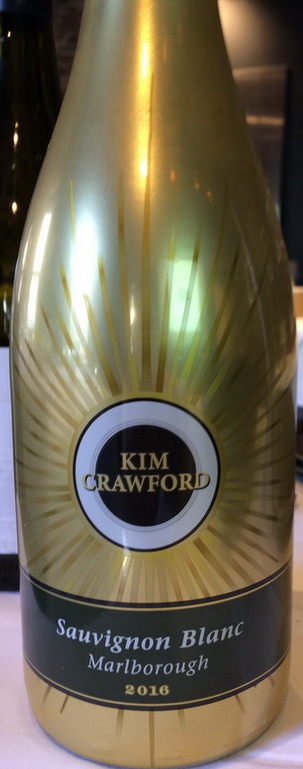 sort though.
sort though.
It narrows the range of tastes that occur from yearly weather variations, meaning there’s rarely a ‘bad’ year. The big factor though is that while each of the component vineyard wines are world class on their own, the whole is better than the sum of its parts.
In our group’s experiments with blending our own creations using the same components used in Kim Crawford’s wine, we found that it takes surprisingly little of a wine to change the overall character of the blend.
Also, the addition of a component wine changed the character of the final result in unexpected ways; my initial assumption was that if you wanted more melon aroma in your wine, you just add more of the component that was more rich in that aroma, but it wasn’t that simple.
For us amateurs, it ended up being much more trial and error based, but it’s obviously both art and science to the pros. As with the complex blending of high-end Champagnes, I marvel at the skill of the winemakers at this level.
It was a fantastic experience. In addition to playing at wine blending, we also sampled some of Kim Crawford’s other wines including the ‘Spitfire’ small parcel Sauvignon Blanc (a step up from even their normal Sauv Blanc worthy of the extra money), their Pinot Noir, and Chardonnay.
All of this on a beautiful fall day at the Courtyard restaurant who put out a fabulous meal.
In this video we learn about the soil, climate and the regions used to create Kim Crawford wines.
Our initiation into blending wine
Jane Staples
Wine Columnist, Ottawa Wedding Magazine
I’m always excited to attend a tasting of New Zealand wines. I love their appetizing aromatics, their clean fruit flavours and zippy acidity.
On Sept. 15th, I had an exceptional opportunity to taste Kim Crawford wines with their winemaker, Anthony Walkenhorst, at the Courtyard Restaurant in Ottawa’s Byward Market. It was a sunny September day. We had a quiet and elegant room for our event and Anthony is a terrific educator.
I have often sampled New Zealand Sauv Blancs, but this detailed comparative tasting went into more detail than usual, discussing several different blocks within the Kim Crawford vineyards.
He led us through a detailed examination of 6 variations of their famous Sauvignon Blanc, throwing light on the different styles and nuances in flavours and aromatics.
Then he invited us to create our own unique blend, using a pipette and the samples we had just studied. What fun!
I decided to first attempt an understated blend of Sauv Blanc from the Rarangi and Rapaura blocks, which I named “ Breakfast Blend”.
Ummm, maybe a little too understated and bland…maybe I don’t have a future as winemaker with a big New Zealand winery…
Not daunted, however, I wanted to achieve a SB with bolder flavours, so next I blended Sauv Blanc from the Blind River and Awatere blocks.
Yes, more like it! Bright and bursting with herbal, citrus and tropical flavours.
I named this “Get Up and Go”.
Lights went off in my head…I could see it all… “amateur winemaker from Ottawa invited to join major New Zealand winery.” Fame! Success! $$$ International food and wine shows!
Somebody beside me noticed that I was talking to myself excitedly and gave me a questioning look. Okay, girl, focus. Back to reality!
This blending exercise gave us quite an insight into the job of a winemaker in developing a new wine blend. There’s a lot of experimentation involved. As Anthony said, he was drawn to become a winemaker because it combines science and creativity.
Meanwhile, we had worked up an appetite by now and were invited to adjourn to another room for lunch. We picked up our favourite Sauv Blanc from the tasting table and sat down to a delicious assortment of appetizers: smoked salmon on crostini, tomato and bocconcini skewers with fresh basil leaves and Prosciutto-wrapped melon balls.
The waiter served Kim Crawford Sauv Blanc and Pinot Noir. I decided that my day was going very well indeed.
The main course was roast chicken with fall vegetables. The totally yummy dessert was an ultra-rich chocolate cake with Dulce de Leche and fresh berries.
My Pinot Noir suited each dish superbly, especially the appetizers and chocolate cake. I’ve always felt that I could, if necessary, live off savoury appetizers and chocolate cake… especially if I have Kim Crawford wine to go with them!
Jon Steeves
Accredited Sommelier & Blogger
On Sept 15th, I met with Kim Crawford’s senior winemaker, Mr Anthony Walkenhorst and enjoyed a tasting of 10 wines. Of the wines, 6 were produced from specific small parcel vineyards in key sub-regions of Kim Crawford’s Marlborough Sauvignon Blanc.
Near the end of the tasting, I was invited to create my own distinctive blends using these small parcel Marlborough Sauvignon Blanc wines and to rate my blends as well.
What a fantastic learning experience, to hear and experience first hand the aromatics, tastes and textures of these diverse Marlborough small parcel wines and to then experiment with blending for myself in the presence of the senior winemaker himself.
The bottom line learning from the blending experience is that the winemaker blended and bottled product is greater than the sum of it’s parts, representing artistic creativity, scientific precision and a deep sense of knowing the earth, the fruit and the way these parts create synergy through vinification.
Senior Winemaker Anthony Walkenhorst’s refresher on the Marlborough region (South Island – NZ) and sub-regions was lively, informative and entertaining with his personal zest for wine and New Zealand wine culture. We covered the following facts about:
– A small parcel lot from Awatere Valley – Sauvignon Blanc showing a slight effervescence in the glass, from fruit which was picked based on acidity, not it’s sugar levels. This wine showed a tropical mango, un-ripened honey dew melon, and minerality which was surprising given I expected more citrus and fresh herb on the palate. Beautiful wine.
– A small parcel lot from Blind River Marlborough sub-region, where rolling hillsides prevail sheltering the vineyards from Southern Arctic winds. This wine produced distinct minerality, gooseberry, citrus peel and herbaceousness.
– A small parcel Sauvignon Blanc from Rapaura sub-region showed richly concentrated, passion fruit, dragon fruit, citrus peel and gooseberry with minerality. This sub-region is located along the Wairau River where river rock and silt preside, lending its impression on the wine.
– A Lower Wairau valley small parcel Sauvignon Blanc showing smooth characteristics, lush guava aromatics, chiseled minerality, medium-full bodied wine.
– A small parcel lot from Rarangi, showed rich mouth-feel, medium plus body, notes of tropical fruit, orange melon – cantaloupe, and ripe peach on the palate.
– A small parcel from the Southern Valleys sub-region offered gooseberry, white peach, and citrus peel, brilliant platinum in the bowl, a real star.
Photo by Jon Steeves
From a distance, for most, looking on a map at New Zealand, Marlborough shows as a dot, yet up close and personal with the sub-regional microclimate diversity, the wines shine clearly differentiated in texture, style, aromatics and taste.
The experience of blending small parcel wines was insightful and surprising. Where texture, taste, aromas and style come together in the glass, the outcomes are often unpredictable.
I learned that even the most rational intentional blending, did not produce the wine blend outcome I sought to achieve and that in the mixing, I found magic, especially where it was not expected.
Lynn van der Linde
Certified Sommelier and Event Planner
I found it interesting to learn that, not unlike many wineries, when Kim Crawford winery started out, they relied on contract growers to spread the “risk” of temperamental years and different terroir.
This, however was how they started blending as a Sauvignon Blanc winemaking “art form”. I didn’t know that Sauvignon Blanc winemakers actually want a variety of flavours and grapes from different soils, giving them the creativity to blend their wines, versus Pinot Noir winemakers who prefer consistent soil for their end creations.
One of the regions in Marlborough – Rapura, is located on the valley floor, where many deposits of different soils collect, including river stones that impart passionfruit characteristics. Fertile soil, where heavier canopies grow end up imparting more herbal flavours.
By comparison, Rarangi is a coastal region, allowing for more free draining soil, where many of the nutrients also drain away, forcing the grapes to struggle and ultimately imparting more acidity in the juice.
The wide variances in soil and climate across Marlborough allow for many different styles of wine to be blended, creating that perfectly consistent, big, bold Kim Crawford Sauvignon Blanc that the world has come to love!
Melanie Aubert
Sommelier & Blogger
I still remember the first time I tried Kim Crawford sauvignon blanc…
The aromas wafting out of the glass were so powerful and amazing, I just couldn’t stop inhaling it.
There was just so much going on there: passion fruit, white peach, pineapple, gooseberry, lime, pink grapefruit, herbaciousness, freshly cut grass, canned peas, minerality…I could go on and on.
It was like a party for my nose and I couldn’t get enough. I think I must have smelled my wine for a good five minutes. It really made an impression on me!
And that’s the thing about Kim Crawford wines: they tend to make an impression.
On September 15, 2016, a group of thirsty wine writers met at the Courtyard Restaurant for fun spin on the generic wine tasting event, where we were given the unique opportunity to play winemaker.
At the event, we were given the unique opportunity to play winemaker. Our host, current KC winemaker, Anthony Walkenhorst, started by going through the main Marlborough sub-regions.
We learned a bit about their climate, topography and soil (all important factors in any agricultural venture) and how these contribute to the sauvignon blanc wines produced there.
The great thing was that as we went through each sub-region, we were able to taste its resulting wine and really see how the distinct aspects of the land made for such different wines, even though they were all Marlborough sauvignon blancs!
The tricky thing about making wine is trying to keep it consistent from vintage to vintage, especially when the weather conditions are anything but. However, having access to such a broad spread of sauvignon blanc wines means Anthony can play chemist to create the telltale Kim blend every year.
From the 240 wines at his disposal, he chooses only the best, narrowing it down to about 120 before starting the trial and error process of finding the perfect blend.
And then it was our turn to try our hand at this winemaking magic. We were given samples of six sub-regional wines, a pipette, an empty glass and a piece of paper to track our measurements, and then challenged to come up with our very own sauvignon blanc blend. And let me tell you – being a winemaker is not easy!
I tried a ton of different vinous combinations, and while my final blend came out better than some of the sub-regional wines on their own, it certainly fell flat compared to the oh-so-distinctive Kim Crawford.
I would like to thank Constellation Brands, winemaker Anthony Walkenhorst, and Natalie MacLean for organizing this fabulous event. It was really nice to spend some time getting to know Anthony and his vision for Kim Crawford wines, learning about Marlborough and its sub-regions, and tasting how they contribute to making one of my favourite wines.
And I cannot forget to thank our venue, the Courtyard Restaurant, for providing such a beautiful backdrop and lunch menu for this tasting (the KC pinot noir paired perfectly with the roast chicken in the curried tomato and butter sauce – YUM).
MBA Professor, University of Ottawa & Wine Blogger
On September 15 I had the chance to attend a blending tasting with Kim Crawford winemaker Anthony Walkenhorst, at the Courtyard Restaurant.While I have tasted several vintages of the excellent Marlborough Sauvignon Blanc, it was fascinating to learn that the wine comes from a blending of sauvignon blanc grapes from six sub regions.More interesting was experiencing the difference in grapes across the sub-regions and how temperature, soil composition and other environmental factors make a significant difference in aroma and taste.My favorite sub-region was the Awatere region which receives cool winds from Antartica, giving higher sugar levels, and resulting in crisp and fresh citrus and herb flavors with a nice stony minerality on the palate. Close runner up was the Lower Wairau sub-region with its warmer climate and tropical fruit flavors.
The highlight of the tasting was the blending experiment where we received blending samples of Sauvignon Blanc from the six sub-regions and an eye dropper to make our own blends. This proved to be a tricky endeavour as finding the right balance of tropical fruit, citrus, gooseberry and herb flavours is not as easy as it sounds.
When Anthony listed off the blending composition of the Kim Crawford Marlborough Sauvignon Blanc, I was thrilled to learn that my first blend was only 10% off the actual blending.
Funny though, my blend did not taste as good as the real one. Now I understand why the Kim Crawford Marlborough Sauvignon Blanc is as acclaimed as it is.
Next time you open a Kim Crawford Marlborough Sauvignon Blanc do not be fooled by its easy drinkability. Blending it took a lot of time and effort!
“When I think of a great Pinot Noir or Sauvignon Blanc, I think of New Zealand, specifically Kim Crawford Wines. One of my first experiences with wine, was with a bottle of Kim Crawford Pinot Noir, and this winery has been one of my favourites ever since.
I, alongside several other wine writers and sommeliers, had the opportunity to be part of a unique and hands-on tasting which was lead by Kim Crawford Chief Winemaker, Anthony Walkenhorst at the beautiful Courtyard Restaurant in downtown Ottawa.
We all gathered in a private room and placed in front of us were nine glasses, eight were filled and one empty, and an eye-dropper.
It was clear that this was not going to be the usual wine tasting experience. We were given the chance to taste Sauvignon Blanc from six-key sub regions (Awatere Valley, Blind River, Rapaura, Lower Wairu, Rarangi, and Southern Valley) and then we had the chance to blend our very own wine.
Winemaker Anthony gave us descriptive profiles for each of the different regions, with the strengths and weaknesses they each possess.
Sadly, my attempts at creating the next great blend for Kim Crawford Wines was short lived after tasting the Spitfire Sauvignon Blanc (70 % Blind River, 20 % Rapaura, 10 % Lower Wairu), which was simply delicious. Winemaker Anthony explained to us the process and some of the struggles he and his team have faced when trying out different blends.
It was clearly demonstrated that the art of blending wine can not be accomplished in only a few short hours, but over many countless hours. Even when his team thought they had made the perfect blend, they had to start all over in order to achieve a blend they were truly proud of.
It was amazing to experience the change in wine profiles from vineyard to vineyard, and how sometimes, wines blended together in the right amounts, can be even better together than on their own. After this experience, it confirmed why Kim Crawford wines continues to be a leader for New Zealand wines throughout the world.
Nicole Lewis
Algonquin Sommelier Graduate
On Thursday, September 15th, from noon to 2pm, at the Courtyard Restaurant on George Street in the Byward Market, I was invited to join Natalie MacLean and a group of sommeliers to attend an event led by Anthony Walkenhorst, winemaker from the Kim Crawford Winery.
The event was dubbed, “Blending Marlborough to Undo Ordinary”.
This event was designed to dispel any notions that Marlborough Sauvignon Blanc all tastes the same. The Sauvignon Blanc grape put New Zealand on the wine map and 70% of the wine produced in New Zealand comes from Marlborough.
In 1996, Kim Crawford started as a small winemaker in Marlborough with contract growers and contract wineries. His product quickly rose to world wide recognition and acclaim.
It was my first time at the Courtyard and I was suitably impressed by its upscale rustic charm, amply exhibited with old limestone boulder walls and thick old lumber beams.
At each place at the U-shaped table, a beautiful mandala of six wine glasses of Sauvignon Blanc were placed along with a spare glass, a glass of the KC Signature Sauvignon Blanc, a glass of the KC Small Parcels Spitfire Sauvignon Blanc and a medicine dropper.
The 6 glasses in a circle contained representative wines from the following parcels: the Awatere Valley, Blind River, Rapaura, Lower Wairau, Rarangi and Southern Valleys. These are the distinct vineyards that Kim Crawford uses to create their signature Sauvignon Blanc Blend.
The big flavours and amazing aromatics in Kim Crawford’s Sauvignon Blanc come from the soil and the climate. Anthony walked us through the distinctions of each small parcel or sub-region. Not only does each sub-region represent a different soil type, but also each a distinct microclimate.
The windy Awatere Valley, a little further south to the main Wairau Valley, is characterized by citrus (lemon-lime), fresh herb flavours and mineralogy on the palate. This wines take longer to ripen where they are often the last parcels to be harvested resulting in higher alcohol wines.
The Blind River’s undulating hills produce grapes that generate a big range of flavours such as grapefruit and gooseberry along with concentration and mineralogy – this area is so dry it must be irrigated.
The Rapaura, the home of Marlborough Sauvignon Blanc, contains some 35-year old vines which provide richness, bell pepper, passion fruit and grapefruit flavours.
Over time, the Wairau River has wound its way through the valley creating pockets of different soil types in its wake. One vineyard can provide a wide range of flavours and this is quite desirable for Sauvignon Blanc, but not Pinot Noir.
The Southern Valleys, a series of five valleys stemming from the main Wairau Valley, have clay based soils that are excellent for Pinot Noir. The wines from this sub-region possess less range in flavours but lend texture, gooseberry and white current flavours. It is not typically a big proportion of the Kim Crawford blend.
The Rarangi (“Sun Valley” in Maori) with its proximity to the Pacific, with little diurnal variation and has well-draining pea gravel and sand. This parcel provides tropical notes such as mango, melon and peach flavours.
The vines from the Lower Wairau, this is where Kim Crawford started and the wine from this sub-region defines the Kim Crawford style. The Lower Wairau is quite fertile and its wines provide power, guava and elderberry flavours.
Anthony asserts that the big flavours and amazing aromatics in Kim Crawford’s Sauvignon Blanc come from the soil and the climate. Also the diurnal temperature variation is a big factor in providing good acidity in KC wines.
The Kim Crawford Sauvignon Blanc is a result of 240 different blending options. The grapes from each vineyard block is fermented separately, then blended.
I was also surprised to learn that there is phylloxera in New Zealand.
Kim Crawford has access to 10% of the Marlborough Sauvignon Blanc grown in New Zealand, representing approximately 2, 500 hectares of vineyards.
It is challenging to determine what the final quality and flavour profile of the final Sauvignon Blanc will be, since the fermentation process is instrumental in the release of thiols or flavour compounds. The thiols are responsible for those passion fruit and tropical notes.
Thus equipped, our task was to blend the six wines from these parcels to see if we could replicate the blend to recreate the classic Kim Crawford flavour profile. We tasted each wine and attempted to create a matching blend. This was quite tricky and subtle.
In the vineyard, one can truly understand why this is a time consuming process!
Another one of my big ‘take aways’ was the great variation in the flavour profiles from the Sauvignon Blanc wines from the six sub-regions! Anthony revealed that classic Kim Crawford blend consists of the 30% Lower Wairau (richness), 20% Rapaura (passion fruit) and 10% Rarangi (pineapple, ripe fruit), 10% Southern Valleys (adding texture), 20% Awatere (herbs) and 10% Blind River (power in terms of flavour).
The small parcel Spitfire is the top wine that Kim Crawford makes. It consists of three wines. Blind River comprised 70% of the blend, where, on account of the hills and slopes, the vines are planted east to west as opposed to the typical north to south rows. The east to west rows lend greater flavour range, owing to uneven ripening. Then Rapaura makes up 20% of the blend and the last 10% is from the Lower Wairau.
This tasting exercise was followed by a lovely meal where we could sample the Kim Crawford unoaked Chardonnay and their Pinot Noir.
Rachelle O’Connor
Wine Blogger & Judge
The Kim Crawford tasting was most enjoyable with the talented wine maker Anthony Walkenhorst.
The exercise in blending sauvignon blanc from various regions was a great way to truly appreciate the various impacts of climate, terroir and landscapes had on the finished product. We tasted in sequence from the Awatere Valley, Blind River, Rapaura, Lower Wairau, Rarangi, and the Southern Valleys.
Anthony is very engaging and his passion for the wines of Kim Crawford is contagious. The products are fabulous, no question.
Most interesting for me was the breakdown of the small parcels of SB. It was interesting to learn the representation or part of the formula from each region coming together in harmony to reveal an outstanding result. (Wairau 30%, Rapaura 20%, Rarangi 10%, Southern Valley 10%, Awatere Valley 20%, Blind River 10%).
Fabulous!
Sylvain Segard
Accredited Sommelier
Malborough is Greater than the Sum of its Parcels
Yesterday, I participated in a blending workshop hosted by Kim Crawford Winery and Constellations Brands in the beautiful stone private dining rooms of the Courtyard Restaurant, in the old Byward Market of Ottawa.
About twenty wine writers and sommeliers from Natalie Maclean’s wine writing team (nataliemaclean.com) had the pleasure meeting Anthony Walkenhorst, the Senior Winemaker with Kim Crawford Winery. Anthony was on tour from New Zealand to explain the art of wine blending in several major Canadian and American cities over the next two weeks.
To demonstrate the art of blending wines, Anthony used New Zealand’s quintessential varietal: the Sauvignon Blanc grape.
While many know that Kim Crawford’s Sauvignon Blanc comes from Marlborough, few realize that the region is made up of 240 smaller parcels and that the Sauvignon Blanc grown in each can produce wines with remarkably different aroma and taste profiles.
We learned that Kim Crawford’s sources its grapes from 120 of these small parcels throughout the Marlborough region along the Wairau and the Awatere rivers and that they ferment and mature the harvest in separate batches. Each year, the KC winemakers get together to assess each batch and classify them according to their aromatic profiles.
They then conduct blending tests to reproduce the iconic flavour profile of the ‘Kim Crawford Marlborough Sauvignon Blanc’ we have come to know. However, they also run separate taste trials to decide which other Sauvignon Blanc blend might best showcase the diverse terroir of these small parcels. One such example that is now available at the LCBO is the ‘2015 Kim Crawford Sauvignon Blanc Spitfire SP’.
Both wines are from Malborough, but anyone could be excused for thinking they came from different regions or that they were vinified through different methods. Indeed, the former shows the classic herbal character and crisp minerality of the KC Sauvignon Blanc that most North Americans have come to know over the last decade. The later, the well-named Spitfire, radiates loads of fresh guava and has an unctuous mouthfeel.
For the practical part of the blending workshop, Anthony had selected six small parcel Sauvignon Blanc harvested from the Awtere Valley, Blind River, Rapaura, Lower Wairau, Rarangi, and Southern Valleys regions of Marlborough.
We were given time to assess each wine and, then, Anthony lead us through each one to explain their different character. He then encouraged us to blend any of the six small parcel wines in different proportions.
While each participants’ experiments may have yielded variable results, everyone enjoyed the trial and the learning. In my view, some of the small parcel wines would make wonderful single varietals wine on their own — for example, the Blind River parcel showed an intoxicating level of tropical fruit aromas.
However, the workshop also demonstrated that judicious additions of other parcel wines made for a superior result, either in the form of a more complex bouquet, a greater balance, or longer finish. Thanks to the expert guidance of Anthony WalkenHorst!
Claira Calderone
Social Media Reporter
What did I learn?
I learned it is very critical for Kim Crawford wines to obtain full ripening of the sauvignon blanc grape.
What surprised me?
Their blending process. The delicacy in each wine featured.
The description of the Rarangi having a pineapple aroma surprised me at first, but I later on smelled and tasted it.
What interesting bits of history, trivia or wine facts caught my attention?
That the Kim Crawford Spitfire Sauvignon Blanc had such a high blend of the Blind River at 70%.
Anthony Walkenhorst telling the group what he’ll be talking about during this tasting.
Colin McKone
Algonquin Sommelier Graduate
On September 15 I participated in the Kim Crawford winemaker’s tasting lunch at the Courtyard restaurant in the Market.
We had the opportunity to blend wines from different vineyards to see how the wine changes with blending.
When we arrived, we had six different Sauvignon Blanc wines in front of us, all of which were from the Marlborough region of New Zealand. Kim Crawford’s winemaker led us through a tasting of each wine and we made notes about the characteristics of each one.
After tasting all of them, the first thing I learned was how individual wines from the same region could have such wide variety of aromas and flavours. After sampling them all we were asked to try and develop our own blend.
I quickly learned how much talent and skill it takes to become a successful wine blender. I came up with two wine blends and the results were less than successful, to put it mildly.
While the intention for both of my attempts was to create a fruit forward blend, all I really succeeded in doing was creating two very acidic wines. Needless to say wine blending takes a lot of skill and experience.
After completing the exercise, I was surprised to learn that Kim Crawford’s iconic Sauvignon Blanc is actually a blend of all six different wines that we had just sampled. While all six individually have their strengths and weaknesses, blended in the right proportions it becomes greater than the sum of its parts.
Another thing I learned at this exercise was the Kim Crawford Small Parcels Spitfire Sauvignon Blanc is a blend of only three of these wines, but the end result is truly amazing.
Another fun fact I learned, completely unrelated to blending, was that Kim Crawford was actually a man. Everyone I have since told was shocked to hear this, so I guess I was not the only one who thought Kim was a woman.
Kim Crawford has since sold the brand which is now owned by Constellation Brands. This was my first winemaker’s lunch/dinner and I would like to thank Natalie MacLean and Constellation for giving me this fun opportunity.
Now I am going to go and get another bottle of Spitfire while I still can.
Camelia Bucar
Certified Sommelier & Blogger
On September 15, during a nice late summer lunch hour, at Courtyard Restaurant in the market, in Ottawa, I had the pleasure to attend a Kim Crawford wine tasting. I must say from the beginning, that I was already a huge fan of their wine before attending this event.
The brand Kim Crawford introduces me to a different palate as I recall in my beginnings of wine tasting days. Even more, I was excited to meet the man behind the creation of the so popular Sauvignon Blanc in the Vintages section of LCBOs, winemaker, Anthony Walkenhorst.
What surprised me at first was that we had eight glasses of white wine and one empty in front of us when we sat down. Usually, during a tasting there are reds and whites already poured down or someone pouring it as we go during the presentation.
The white samples caught my attention. As Anthony presented all the glasses in front of us, I started to realize that all those samples are different Sauvignon Blancs from different vineyards on the estate.
We had the pleasure to taste wines from Awatere, Blind River, Rapaura, Lower Wairu, Rarangi and Southern Valleys regions. These different Sauvignon Blanc grapes have their own flavours and aromas.
The climate and the soil that each one of them are planted give their aromatic flavours which are distinct. Also, there flavours comes from the separate fermentation and the yeast.
I was surprised to taste such wild range of flavours from each of them. We all know that New Zealand Sauvignon Blanc should taste like herbaceous, grassy, citrusy, green apple style.
It was unexpected to taste a more tropical fruit (i.e. passion fruit) forward or even more flower notes (i.e. elderflower) on Sauvignon Blanc. It tasted like an aroma wheel of Sauvignon Blancs.
What I learned as we tried the eight different samples is that the popular Kim Crawford Sauvignon Blanc is a blend of these eight samples in different percentages (i.e. rich flavours, texture or power).
Each year, the winemaker and his team, during a week trial and error blend all the eight different Sauvignon Blancs to recreate the wine that we see on the shelves at our local liquor store.
The fun part of the tasting was to recreate it or to create our own blend of Kim Crawford Sauvignon Blanc. My favourite blend was Awatere, Blind River and Lower Wairau. I could have these wines on their own and not blended together.
After the presentation, we had the pleasure to enjoy a very exquisite lunch  accompanied at the table by Anthony.
accompanied at the table by Anthony.
It felt more personal as we had the chance to ask him more questions and to get to know the person behind the winemaking. He sat down with each one of us and answered all our questions.
I’m always curious to know what kind of wine or cocktail the winemakers are enjoying outside their working hours. Anthony shares his love for the full-bodied shiraz of Australia (his country of birth) or a simple gin and tonic.
I would like to thank Anthony Walkenhorst for the time he spent with us and answering all my questions.
Greg Hughes
Sommelier & Blogger
In 1996, Kim Crawford began production. They had to purchase from a lot of different growers. They were relatively small, under-developed (NZ was a new wine frontier), and didn’t have a lot of money.
Kim Crawford still stays true to the heart of their operation – the Lower Wairau area.
Apparently a lot of the Sauv Blanc flavours are hard to discern from the grapes. The yeast and fermentation create a lot of the compounds they are looking for (volatile thiols). These compounds can be coaxed out of precursor compounds to produce the crunchy herbaceousness that is representative of New Zealand Sauvignon Blanc. Other grapes, such as Gros/Petit Manseng and Semillon, can often rely on these compounds as well.
The typical blend from them would be around 120 different vineyards blended in. The single vineyards are around one percent of production.
Kim Crawford’s actual blend recently
Lower Wairau base – 30%
Rapaura – 20%
Rarangi – 10%
Southern Valleys – 10%
Awatere – 20%
Blind River – 10%
Spitfire
Blind River – 70% north to south rows to hit canopy in one part of the day and the other later on. This creates an herbaceous range of flavours.
Rapaura – 20% richness to compliment aromatics.
Lower Wairau – 10% for classic zing
Regional Typicity Breakdown:
6 different regions:
Awatere: windy area reduces the yields and extends the growing season.
The wines have a distinctly citrusey focus, with a little bit of chlorophyll.
Blind River: requires irrigation from Awatere river. Relatively new and underdeveloped. Not too fertile, but also a lot of undulating hills. Plantings are on the slopes.
Dissolved CO2 is coming out. Less aromatic, but still NZ. Lots of white fruit and crushed rocks.
Rapaura: classic NZ sauv. Infertile, with lots of rocky soils.
They say bell pepper, more like crunchy herbaceousness. Chlorophyll and dried tomato leaf or basil. Tons of concentration. Pretty lean and mean. I can get the passionfruit, but more ugli fruit and grapefruit.
Southern Valleys: disclosed as one dimensional, but excellent for providing mouthfeel and overall texture. Apparently, it is a better area for Pinot than Sauv Blanc. Not so aromatic. Lots of texture. Lithe and mouthfilling.
Rarangi: close to the ocean. Coastalness ripens early. They pick it on its acid, rather than the sugar.
Melon and white fleshed apple.
Lower Wairau: original area of KC. Lots of shading and are healthy. Flavour is driven into the grape.
Unmistakeable tropicality. Truly a standout. Floral, with guava.
Heather Wall
Wine Columnist, Huffington Post Canada
Kim Crawford Tasting
Thursday September 15, 2016
Courtyard Restaurant
I’ve often referred to winemakers as “artists” and winemaking as “crafting” in many of my wine related articles.
On Thursday September 15, 2016 I took part in a Kim Crawford blending lesson with winemaker Anthony Walkenhorst at the Courtyard Restaurant in Ottawa’s Byward Market.
We were given six glasses of Sauvignon Blanc from selected vineyards throughout the Marlborough region and a dropper. Each glass contained site specific attributes.
For example: Wine #1 was generally higher in alcohol and more herbal. Wine # 2 from a more southern part of Marlborough generally powerful and so on…you get the exercise.
Today I’m a winemaker with 6 parcels of land and I’m going to craft a beautiful wine! With my trusty dropper in hand I begin to blend, making notes as I add a drop here and there from my six glasses, tasting as I go along and making notes.
I need more acidity so I add from #2; maybe not enough fresh herbs so I add from #1; aromatics are lacking so add from glass #3; texture #6 and some richness from glass #4. My Kim Crawford blending experiment is done!
Now to taste my wine next to iconic Kim Crawford Sauvignon Blanc – a Vintages Essentials.
And now I have proven my adjective for winemakers as stated above. They really are artists and craftsmen(women). They have a passion for the fruit, place and science that is winemaking.
At the end of each harvest Anthony has 240 tanks at his disposal and just one week to assess the juice in each of those tanks. Using those tasting notes he will produce his vintage of Sauvignon Blanc whilst keeping in mind the style of Kim Crawford Sauvignon Blanc consumers have come to know and love.
I had just 6 parcels of land and let me just say that my wine was not so good. Next to Anthony’s Sauvignon Blanc my wine was thin, acidic, and far less aromatic.
The moral of this story for me was the affirmation that each bottle of wine is a collaborative expression of the grape, the land, the labour, the growing season, and the winemaker. It definitely takes more than a medicine dropper and one hour.
Anthony’s closing remarks
Kim Crawford Sauvignon Blanc 2015
Marlborough, South Island, New Zealand
Kim Crawford Spitfire Sauvignon Blanc 2015
Marlborough, South Island, New Zealand
Kim Crawford Unoaked Chardonnay 2013
Marlborough, Hawke’s Bay, East Coast, New Zealand
Kim Crawford Pinot Noir 2014
Marlborough, New Zealand



